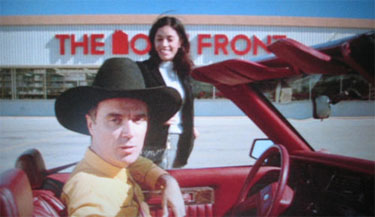Chapter Two: True Stories
By Brett Beach
December 9, 2010
In the illustrated official screenplay - containing many scenes and subplots that were cut to obtain the 89 minute running time - that accompanied the film’s release, Byrne notes that the genesis for many of the film’s characters and ideas was the tabloids that people always linger over in the checkout lanes as their vegetables and canned goods go down the conveyor belt. He admitted that there was a part of him that always wants to believe those stories are, well, true. Is he being sincere? This is, after all, the same individual who staged dramatic readings of transcribed game shows for fun while he was in college, and whose most recent musical effort was collaboration with Fatboy Slim on a pop opera suggested by Imelda Marcos’ life. Quirk and kitsch have been the fodder for many of his inspirations.
I feel as if he has always approached the topics of his art with the intentional naïveté of a child, the need to see things from a different perspective, less jaded or cynical. It probably isn’t a coincidence that True Stories opens with a held shot of a young girl walking down a dusty road towards the camera making bird calls and other noises and closes with her retracing her steps. His film seems as innocent at times as that youngster and though it walks a fairly straight narrative line from beginning to end, it is adorned with oddball behavior.
Byrne directed and co-authored the screenplay for True Stories, receiving an “and” credit in the final accordance, alongside the ampersanded team of Pulitzer Prize-winning playwright Beth Henley & long-time milquetoast character actor Stephen Tobolowsky. For nearly 25 years I have looked at those names and wondered, as no doubt you do, “How the hell did that collaboration come about?!” I finally determined to answer my own question. Henley and Tobolowsky were an item for a number of years encompassing the late ‘70s and early ‘80s, stemming from the fact that the pair attended Southern Methodist University at the same time. Both were born, as Byrne was, in the early ‘50s and the two of them hailed from the South and Midwest: she from Mississippi and he from Texas.
I have no way of categorically determining who brought what to the screenplay, but I do feel that the film is stronger for having multiple voices bringing life to Virgil’s citizens. If Byrne’s sole intention was to satirize and mock, he could have easily written those barbs himself. By working with creative types that he evidently felt a kinship with, and who had grown up in the milieu in which the film would be set, I feel his true intentions towards the project are brought into focus. But whence this gravitation towards the Midwest?
I have always considered True Stories a follow-up of sorts to Talking Heads’ tune "The Big Country,” the twangy shuffle that ends their divine 1978 album, More Songs About Buildings and Food. The unnamed narrator of “Big Country” spends his life in planes observing urban and then small-town life reaching the early conclusion that he “wouldn’t live there if you paid me to” before deciding in the end that he “needs to be somewhere” and he will take his chances on land.
Continued:
1
2
3
4
5
|
|
|
|




